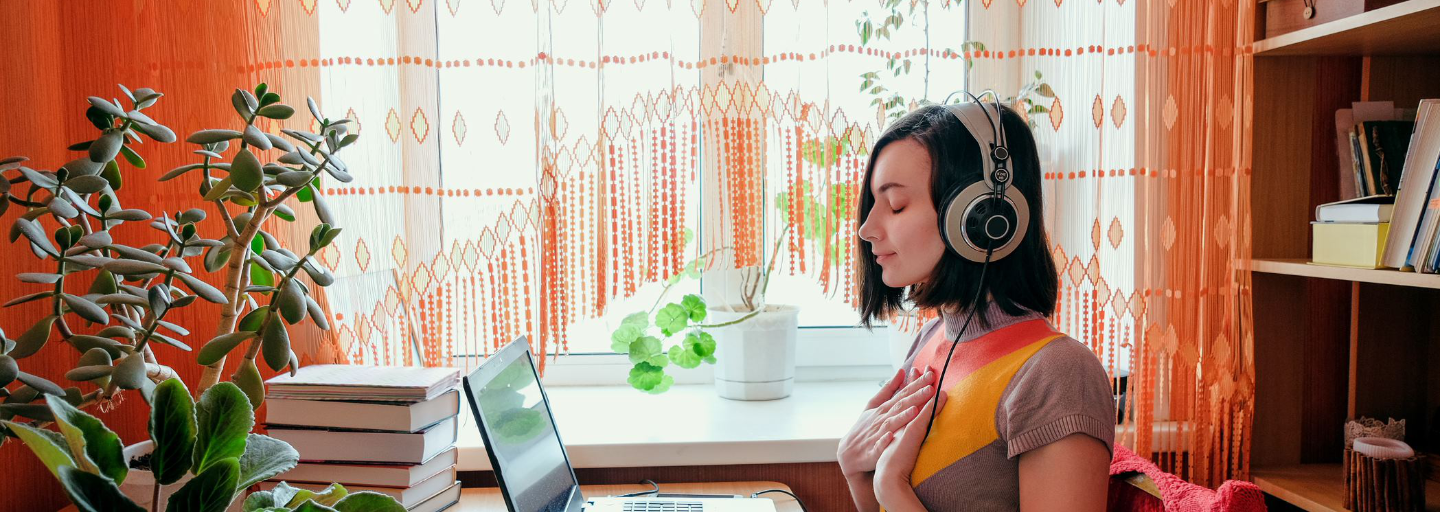Self-help program
7. Tackling hyperarousal (SOS)
Techniques for calming down the nervous system
Exercises that calm down the nervous system can provide much-needed relief and help to relax both body and mind.
We recommend doing exercises that calm the body and reduce hyperarousal on a regular basis. A good time is whenever you feel tense or start to feel nervous about going to bed. These exercises can also provide acute relief from insomnia.
How can practising help?
Calming the body and reducing hyperarousal through emotions and physical sensations.
NOW: EMOTION
NOW: PHYSICAL SENSATIONS
Thought
Action
Diaphragmatic breathing
Several muscles are involved in breathing. The most effective of them is the diaphragm.
Anxiety and stress can lead to a reduction in diaphragmatic breathing. This makes breathing shallower and more labored. The diaphragm tenses, which either increases anxiety or causes you to feel anxious. This often happens without warning.
Soothing effects of diaphragmatic breathing
In diaphragmatic breathing, the abdomen expands while inhaling and contracts while exhaling. This draws oxygen all the way down into the bottom of the lungs.
The same result cannot be achieved with shallow, labored breathing, as this can create a feeling of breathlessness.
Concentrating on diaphragmatic breathing and taking deeper and slower breaths usually induces a feeling of calm. The effect can be almost immediate. Using the correct breathing technique also helps other muscles to relax.
You can stop yourself from breathing too fast by leaving a gap between inhaling and exhaling.
Mindful breathing
Breathing is at the core of many relaxation and mindfulness exercises. Focusing your attention on your breathing is a good way to ground yourself if you are having difficulty concentrating or feeling frustrated.
Anxiety-reducing effects of diaphragmatic breathing
Practicing diaphragmatic breathing provides a quick way to alleviate anxiety.
Another way is to consciously work through different muscle groups in the body, relaxing first your shoulders, then your jaw, and so on.
Diaphragmatic breathing (0:31)
Goal
Learn to pay attention to your breathing and practice calm diaphragmatic breathing. This alone can be enough to relieve feelings of anxiety.
Instructions
- Find a comfortable position.
- Place one hand on your chest and one hand on your abdomen.
- Breathe in and out slowly.
- Make sure that only the hand on your abdomen moves with each breath. In other words, your chest should not be moving.
- Focus your attention on your breathing, and keep breathing in this manner.
Count each breath going in and coming out: “in 1, out 1, in 2, out 2”, and so on. Aim to get to a count of 10 without quickening your breathing. If you lose focus, start again from number one and try going slower. You are not in a hurry.
Practice diaphragmatic breathing first with the help of the video (subtitles in English). Do the exercise when you feel your anxiety levels rising to a point where they start to interfere with whatever you are doing.
It is important that you repeat this exercise several times. There is no need to worry about whether you are doing it correctly or at the right time. The main thing is to try to do it.
Relaxation exercise (SOS)
Relaxation exercises help you to identify states of tension in the body and to relieve them. You can incorporate a relaxation exercise into your evening routine to help prepare your body for sleep.
Progressive muscle relaxation is a technique based on the simple practice of tensing one muscle group at a time and then releasing the tension. It is often easier to relax your muscles after you have contracted them in an exaggerated way.
Progressive muscle relaxation can alleviate feelings of tension and anxiety.
Progressive muscle relaxation (12:59)
Goal
Learn to progressively tense and then relax each muscle group.
Instructions
Gradually work your way through the body, contracting and relaxing muscle groups to learn the difference between feelings of tension and relaxation.
Find a quiet place in which to do the exercise, and where you can lie down either on the floor or on a bed.
It is important that you do this exercise more than once. There is no need to worry about whether you are doing it correctly or at the right time. The most important thing is to try it.
Other ways to calm the body and the mind (SOS)
As the evening wears on, performance anxiety about falling asleep starts to build. In addition to the exercises featured above, several other techniques can be helpful in situations where you need to calm your body and mind. The following are just a few examples:
- Stroking the back of your hand
- Hugging a pillow
- Cuddling a pet
- Taking a shower
- Reassuring yourself with phrases such as “False alarm, there is nothing to worry about”.
- Some other technique that works for you
Well done! You have already learned and tried a number of techniques for calming the body and the mind.
